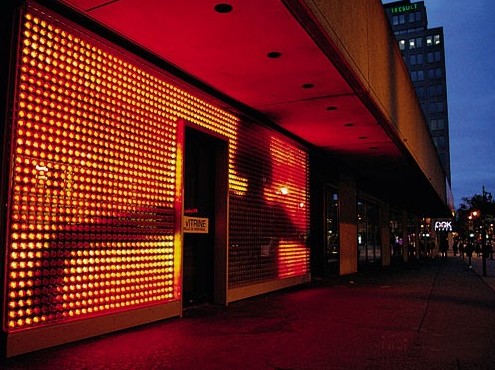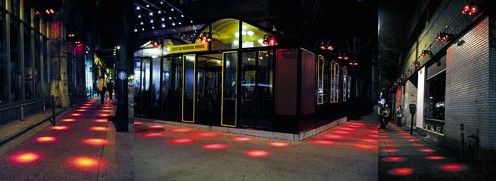
The Showcase Partnership is a non-profit organization supported by commercial trade, government agencies and art investment. Founded in 2003. The company is focused on promoting the development of various theaters and exhibition halls on the east side of the Montreal City Center. Until the establishment of the partnership, although each functional site is very close, there is an ambiguous relationship. In order to create a unified and unified character for urban space and to bring it new vitality, the city of Montreal held an interdisciplinary competition in 2005, calling on all parties to make suggestions to help create a cohesive “brand†image. There were five participating groups, and the winner was the concept co-conceived by Integral Ruedi Baur and Integral Jean Beaudoin. They use lighting to illuminate the entire area, making it a common thread throughout the whole, with a tortuous bright band of light along the contours of each field and the streets between them.
While lighting is a major component of this design philosophy, designers have taken other steps to complement it, from permanent installations like signage, signage and graphics systems to art or technical equipment. Temporary facilities, these elements are combined in the overall design to form rhythm and rhythm.
Of the five groups participating, only Axel Morgenthaler is a lighting designer. Although he was not originally a member of the Bauer and Baudan design groups, he was added to the winning team when lighting was identified as one of the key elements of the final project design. His expertise clearly helps the successful implementation of the design concept.

Mogenter is from Switzerland and is currently the chief designer of the lighting design company Photonic Dreams. He has a deep research on dance and theatre lighting design. He has actively participated in art community activities in his early years and has organized collective exhibitions in collaboration with painters and sculptors. His interests range from furniture and industrial design to graphic design. But his favorite art is lighting, whether it is stage lighting design, urban environmental lighting design, or just lighting as a work of art. Of course, his enthusiasm for lighting has also appeared in front of people with his design works. As a recipient of numerous local and international drama, dance, multimedia, art and urban lighting design awards, he is responsible for the lighting design of many high-profile projects, especially in the city he calls “homeâ€.
“Sometimes I call myself a lighting ambassador, just to make people know more about what I am doing,†Morgantte said. In order to turn the lighting idea of ​​the Montreal showcase into reality, he first needs to find the "canvas" he wants. Since the pavement was the "quickest" "canvas" surface, Morgantte made a careful selection. He designed a custom 4-head lighting fixture that evenly projected four red spots on the ground. These luminaires are extremely energy efficient, each with a power consumption of only 12 watts, which coincides with the vision of the District Partnership “Creating a More Sustainable Cityâ€.
The N red spot itself is Bauer's interesting graphic design based on red theater curtains, red carpets, and red velvet ropes that define the queuing position. In addition, if you know that this area (and still some now) is a red light district, then you can better understand why this design concept has both a semi-truthful irony and a cultural background.

In 2006, five important theaters were selected as the first place to be implemented in this planning and design:
1. SAT - Society for Arts and Technology. This is a versatile space for seminars, concerts, lectures and art and digital media exhibitions.
2. TNM - Theatre de Nouveau Monde/New World Theatre. The theatre has been in operation for over 57 years and is at the forefront of the Quebec Theatre, featuring classics and avant-garde plays.
3. Club Soda, originally a nightclub with cabaret performances, was remodeled in 1999 into a medium-sized concert hall/reception hall. Whether it is a local talent or an international superstar, you can perform on this stage.
Metropolis - once a film theater, officially became a concert venue in 1997. It has been in operation for decades and can accommodate 2,300 spectators.
Monument National - The theater is currently owned by the National Theatre School of Canada and features a versatile reception area and a music hall. It is one of Canada's oldest theatres, often hosting new books or CD conferences, performing dance and theatre productions, and holding press conferences.